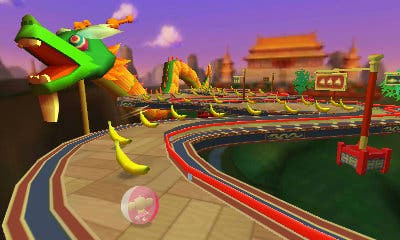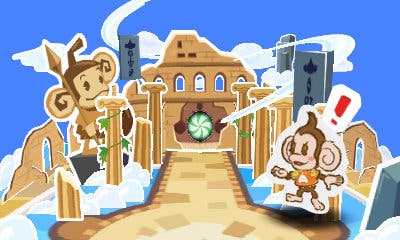Super Monkey Ball 3D
The apes of sloth.
Satoru Iwata's startling GDC 2011 speech saw the Nintendo president talk in provocative terms about the importance of "maintaining the value of gaming." "Content is king," he insisted, as he tore into the quantity-over-quality approach of mobile gaming platforms.
It's reasonable, therefore, to imagine Iwata being slightly dismayed that a number of 3DS games launching alongside his company's latest console are little more than ports or franchise updates with a 3D makeover. And with the AppStore likely to have forever realigned the perception of value for money when it comes to portable gaming, it's more important than ever that 3DS software – especially given its increased retail price – offers both quantity and quality.
And so we come to Super Monkey Ball 3D, a game whose end credits you can reach in roughly 90 minutes.
That's not the full story, but even so, you may be shocked at how quickly you'll whizz through the seven themed worlds and the playable credits, a ludicrously extended sequence which must count for around 10 minutes of that tally alone.

You can, however, expect that total to increase quite a bit if you're using the tilt controls. Before leaping into a world – via a charming papercraft cut-scene that briefly made me ponder the potential merits of a Nintendo/Sega collaboration called Paper AiAi – you're given the option of using either the circle pad or the console's internal gyroscope to move the levels around your monkey. The latter is impossible to play with the 3D on unless you fancy a migraine for the rest of the week, so for my first run-through I opted for the former, hoping for a more traditional Super Monkey Ball experience.
Unfortunately, because the game is designed to accommodate two control schemes with differing levels of accuracy, you're greeted by wide pathways and barriers to prevent you from falling off. This was understandable in the Wii's Banana Blitz, which had the limitations of Nintendo's remote controller to consider, but the responsiveness of the circle pad means you'd have to be pretty careless to lose a life on the first four or five worlds, let alone require a continue.

The hazards you will encounter are often nothing more than minor frustrations. Bumpers rarely have the power to send you spinning to your doom, but simply set you back a few seconds as you push forward and wait for the sluggish camera to realign. There are unavoidable patches of sticky ground that exist merely to slow your progress: hindrances, rather than challenges.
Then World Seven's space factory arrives, heralded by the best piece of music in the game (as a robotic voice rather vulgarly insists that it is going to "freak your body") and the game starts to find its feet. The level design improves markedly, and you may even occasionally witness your chosen chimp tumbling into oblivion. It's too little, too late, but at least once you've trundled through the series' weakest credits mini-game to date, another world opens up, this one offering a few tests that those using motion controls will certainly struggle with.


